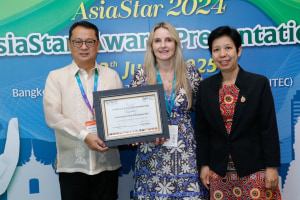We are entering the fourth major era in food processing. Dr Anneline Padayachee outlines what this means and how nutrition will be the foundation.
The processed food industry originated in early human history when non-thermal processes like pounding, grinding, and sun-drying were used to increase diversity on a relatively limited menu, increase shelf-life, and make it easier to chew hard things like grains, seeds, and fibrous reed.
Like most things in society, the purpose of processing food has changed over time, with three major transitions:
Food System 1.0: The Agricultural Revolution, which changed the nomadic hunter-gatherer food supply to asteadier supply that was needed to establish settled societies with agriculture and livestock farming.
Food System 2.0: The Mass-Safe Processing Era occurred at the start of the Industrial Revolution (1800s) and delivered improved food safety (e.g. pasteurisation), food preservation (e.g. canning), and decreased micronutrient deficiencies with a more steady food supply.
Food System 3.0: The Automisation, Liberalisation and Globalisation Era from the early 1950s. This promoted economic growth while increasing the risk for over-consumption and non-communicable diseases due to a readily available supply of convenient, palatable, and extensively transformed energy-dense foods (e.g. soft drinks and confectionery).
The legacy of Food System 3.0 is the era the food industry now finds itself in:
Food System 4.0: Healthy Food Innovation, where consumer demand for safe foodwith greater health benefits and sensory qualities isthe foundation.

What Food System 4.0 means is a move beyond a linear or circular food system mindset to a more multi-disciplinary approach in which nutrition is an underlying principle (See diagram above).
The move away from models like the value chain, the food supply, or food cycle is because they do not capture the complex inter-connected relationship of a dynamic food system.
According to the Organisation for Economic Co-operation and Development (OECD), a functioning food system not only focuses on food security, safety, and availability, but aims to ensure better access to “sufficient, safe and nutritious foods that meet dietary needs and food preferences for an active and healthy life”.
Nutrition conundrum
Although the role of food has primarily been a source of nutrients, nutrition is often excluded from traditional food system domains (i.e. food safety, food supply, value systems) and quarantined to the health foods or marketing silos.
Given that food with greater health benefits is central to
Food System 4.0, it is important to rethink the role of nutrition in this evolving, complex, food system.
Part of the conundrum surrounding nutrition is that it means many different things to different people, from specific nutrients (e.g. protein) to specific foods based on their nutrient composition (e.g. egg whites and protein) or nutrition-related health outcomes and disease states (e.g. diabetes mellitus and glucose).
Professor Mike Gidley is the director of the Centre for Nutrition and Food Sciences at the University of Queensland.
He says, “It is important for the food industry to understand that nutrition is not the concept of a single food or a single nutrient. Rather nutrition comes from the sum total of food we eat over time. And nutrition-related health outcomes stem from the combinations of foods (due to their different nutrient qualities) we consume.”
Simply put, nutrition is a complex multi-disciplinary science in which compounds in foods consumed has health and wellness outcomes over time for individuals and collectively at the societal level.
Nutrition cannot be isolated to its own little silo, but rather requires a holistic approach in which the environment, quality of life, dietary patterns, foods sources, the net effect of the food matrix (food structure and nutrient-nutrient interactions), and basic nutrients are all taken into account.
What does Food System 4.0 mean for the current food industry in real-time?

There are three key points to start considering.
1. Nutrition is not confined to health foods or marketing
We all have to face the fact that the food we consume not only impacts our own health and wellbeing, but that collectively we all impact the health and wellbeing of society.
Gidley says, “To be clear, this isn’t about a healthy part of the diet, or an unhealthy part of the diet. Nutrition is the sum total of the diet.”
Move over “health food”, “diet foods”, and “functional foods”, it is time for “foods with function”. Consumers want to know how a food will help
them achieve health and wellbeing outcomes, with evidence of course.
2. Create healthier products using novel technologies
Food processing technologies like pasteurisation, canning, spray drying, and retorting are stock-standard expectations.
It is time for novel processing technologies that can improve, or at the very least maintain food safety while enhancing health properties to step up.
For example, non-thermal technologies like high pressure processing (HPP) that destroy microbes while maintaining nutritional composition. It wasn’t too long ago that HPP juice was novel, but as HPP moves more mainstream, applications include “cold pressed” milk, processed avocados, and short-shelf-life meal kits, all of which have better shelf life without compromising nutrition through heat or additives.
Food structure technologies like 3D printing that incorporate bioactive compounds (e.g. nano-encapsulation) allow for targeted nutritional delivery. It can also open opportunities for personalised nutrition innovation for specific dietary requirements such as allergies.
3. Knowledge translation is key for success
The medical system, which largely functions for the treatment of ill-health, seesresearchers assessing diseases and age-related ill-health working hand-in-hand with clinicians to improve treatments and delivery.
The lag phase between medical research and medical application is minimal and the system runs with application in mind.
This application-driven mindset needs faster adoption and buy-in throughout the food supply chain.
The lag phase between the research sector and the commercialisation sector in the food industry will inevitably shorten as we focus on transformative ideas for the creation of technologies that enable nutritional health outcomes through the food supply.






